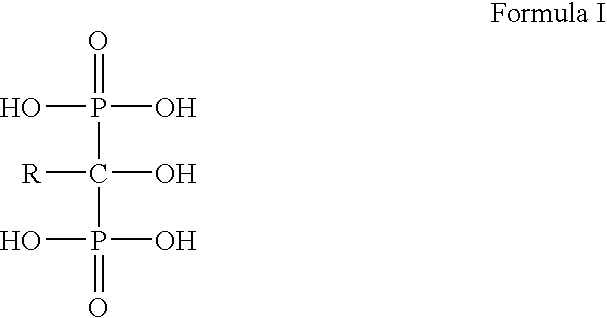Process for the preparation of biphosphonic acids
a technology of biphosphonic acid and process, applied in the field of bisphosphonate compound production, can solve the problems of inconvenient commercial production of process, inefficient use on a large scale, safety problem surfaced,
- Summary
- Abstract
- Description
- Claims
- Application Information
AI Technical Summary
Benefits of technology
Problems solved by technology
Method used
Image
Examples
example 1
Preparation of 1-hydroxy-2-(3-pyridinyl)ethylidene-1,1-bisphosphonic acid (Risedronic acid)
[0028]A mixture of phosphorus acid (35.9, 0.44 moles), 3-pyridylacetic acid (20 g, 0.15 moles) and phenol (80 g) were heated to 65° C. and phosphorus trichloride (68.2 g, 0.49 moles) was slowly added over a period of 30 min to 1 h while maintaining the temperature at 65-70° C. The reaction was allowed to continue for 4 h, after completion of the PCl3 addition. Then the reaction mixture was hydrolyzed by addition of water (160 ml) at 95° C. for 6 h. Aqueous layer was separated and methanol (320 ml) was added where upon the product precipitated out. The resulting precipitate was cooled to 0° C. and aged for 2 h. The obtained white product was filtered, washed with methanol (2×20 ml) and dried to obtain 26 g of Risedronic acid (Purity: >99%).
example 2
Preparation of 1-hydroxy-2-(3-pyridinyl)ethylidene-1,1-bisphosphonic acid (Risedronic acid)
[0029]A mixture of phosphonic acid (89.7 g, 1.09 mole), 3-pyridylacetic acid (50 g, 0.36 moles) and p-Cresol (230 g) were heated to 65° C. and phosphorus trichloride (170.5 g. 1.24 moles) added in 1 h and maintained for 4 h at 65-70° C. The reaction mass was cooled to 10° C. and pre-cooled DM water (800 ml) was added, and then heated to 95° C. The reaction mixture was maintained at 95-100° C. for 6 h. Cooled to 40° C., methanol (800 ml) was added and stirred for 2 h at 2-5° C., filtered and washed with methanol (2×250) and dried to obtain 60 g of Risedronic acid.
example 3
Preparation of 1-hydroxy-2-(3-pyridinyl)ethylidene-1,1-bisphosphonic acid (Risedronic acid)
[0030]A mixture of phosphorus acid (134 g, 1.64 moles), 3-pyrdiylacetic acid (75 g, 0.55 moles) and p-nitrophenol (442.5 g) were heated to 65° C. and phosphorus trichloride (259.7 g, 1.89 moles) was slowly added over a period of 2 h at 60-70° C. The reaction mass was allowed to continue for 4 h, after completion of the PCl3 addition. The reaction mixture was hydrolyzed by slow addition of water (750 ml) and conc. HCl (56 ml). After 12 h at 95-100° C., the reaction mass was cooled methanol (1400 ml) was added to precipitate the product. The resulting precipitate was cooled to 5° C. and aged for 2 h. The product was filtered, washed with precooled mixture of methanol and water (1:1 v / v) (2×110 ml) and dried to obtain 137 g of Risedronic acid (purity>98.5%)
PUM
| Property | Measurement | Unit |
|---|---|---|
| temperature | aaaaa | aaaaa |
| temperature | aaaaa | aaaaa |
| temperature | aaaaa | aaaaa |
Abstract
Description
Claims
Application Information
 Login to View More
Login to View More - R&D
- Intellectual Property
- Life Sciences
- Materials
- Tech Scout
- Unparalleled Data Quality
- Higher Quality Content
- 60% Fewer Hallucinations
Browse by: Latest US Patents, China's latest patents, Technical Efficacy Thesaurus, Application Domain, Technology Topic, Popular Technical Reports.
© 2025 PatSnap. All rights reserved.Legal|Privacy policy|Modern Slavery Act Transparency Statement|Sitemap|About US| Contact US: help@patsnap.com



